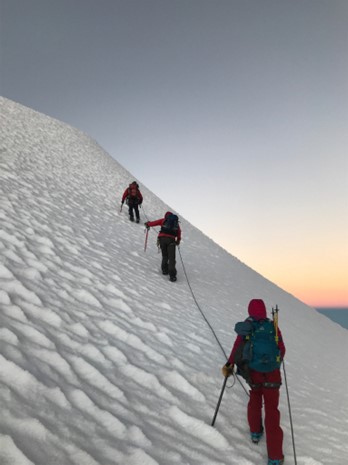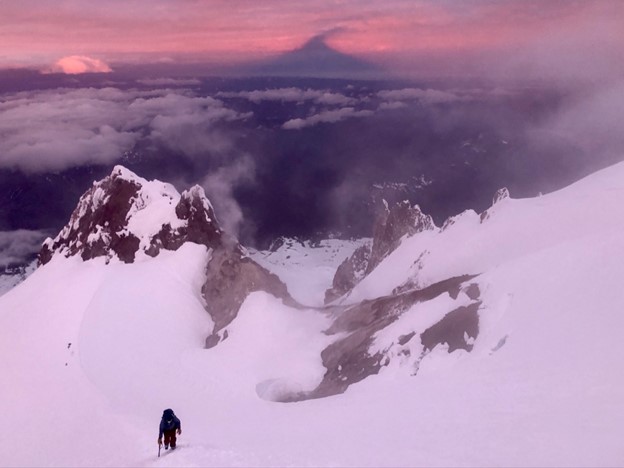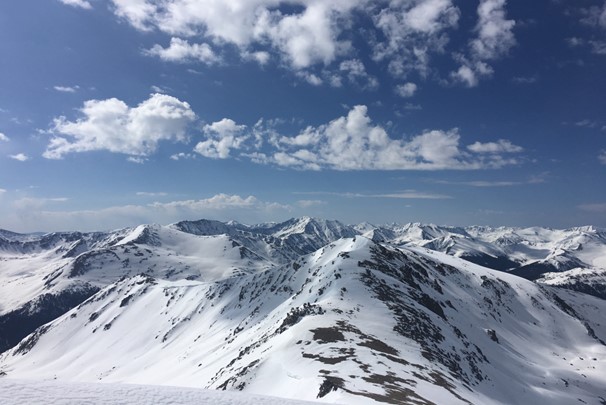If your hands or feet have ever gotten painfully cold while out ice climbing, skiing, or just enjoying the fresh brisk air of winter, you probably know what this article is about just by the title. The screaming barfies, also known as hot aches in the United Kingdom, are a type of non-freezing cold injury that occurs when the body is no longer able to maintain heat balance, inducing sympathetically mediated peripheral vasoconstriction. This decreased blood supply causes the extremities to cool, which prevents heat dissipation to the environment but often causes numbness and decreased dexterity. When the core body temperature increases enough, vasodilation returns blood flow to the extremities. The reperfusion causes pain which increases to a climax, usually with throbbing, and is followed by systemic symptoms such as nausea and occasionally vomiting or changes to vision or hearing. Hence, the screaming barfies. This most often occurs in the hands as they are the furthest from the core and are easily raised above the heart whereas the feet benefit from gravity pulling blood - and with it heat - to the lower extremities. A recent Gripped article describing the phenomenon also shows some videos of ice climbers mid-barfies.

Figure 1: Climbing El Diablo Mudo in Cordierra Huayhuash, Peru. Photo credit: Andre Wille
Hot aches were originally defined in the scientific literature by Melvin & George (2016) who surveyed 386 ice climbers in the United Kingdom. Among this study group, 96% had experienced hot aches and most commonly described them as lasting 1-5 minutes and reaching 3-4 on a pain scale where 5 was the highest rating. Associated throbbing, tingling or aching were described by about half of respondents. Hand symptoms were followed by nausea in 44% of climbers, but only proceeded to vomiting in 4% (Melvin & George, 2016). Other systemic symptoms included irritability (32%) and dizziness (20%) (Melvin & George, 2016).
Pathophysiology
Several theories exist as to the physiology of the screaming barfies, including the prefreeze phase of frostbite, ischemia, reactive hyperemia, and cold-induced vasodilation (CIVD). Cold stimulates release of smooth muscle cell reactive oxygen species (ROS) which ultimately increases calcium sensitivity leading to vasoconstriction (Bailey et al., 2005). Reactive oxygen species produced through ATP degradation during ischemia, and superoxide anions in particular, are associated with ischemia-reperfusion injury in a wide variety of animal models (Rosenberry & Nelson, 2020). Cold-induced vasoconstriction causing ischemia to the affected fingers or fingertips is one of the theories behind this phenomenon. Reactive hyperemia is a physiologic mechanism where vasodilation results in blood flow above baseline after a period of arterial occlusion (Rosenberry & Nelson, 2020). The degree of reactive hyperemia is reflective of microvascular function (Rosenberry & Nelson, 2020) suggesting that the phenomenon may actually reflect a healthy vasculature. Cold-induced vasodilation (CIVD) is a paradoxical response where the body actually increases peripheral blood flow to prevent cold injury to the extremities (Flouris, 2008), although literature on CIVD does not mention pain which is a central component to the screaming barfies. Frostnip has been described as having some similar features, including numbness followed by pain, tingling and burning sensations although no systemic symptoms have been discussed (Tlougan et al., 2011). In frostbite, a combination of hyperviscosity, microvascular injury, venous stasis, and microthrombi contribute to arterial ischemia (Basit, Wallen & Dudley, 2022). However, this is degree of damage is likely beyond that seen in the screaming barfies.
Regarding the nausea component, a buildup of metabolic waste suddenly being transported back to the core has been considered as a potential cause of nausea in this syndrome. Others include pain-induced nausea and transport of endothelial vasodilatory substances back to the core.

Figure 2: Approaching the bergschrund on Mt. Hood, OR. Photo credit: Alicia Lycan
Susceptibility
Frostbite susceptibility factors include the following: peripheral vascular disease, malnutrition, Raynaud’s disease, diabetes mellitus, tobacco use, and others that impair vasoreactivity (Basit, Wallen & Dudley, 2022). In a study of nonfreezing cold injury in paddle sport athletes appearing in Wilderness and Environmental Medicine, cold intolerance was increased in females, smokers, individuals with Raynaud’s phenomenon, or previous nerve injury (Oakley et al., 2022). Increasing age and substance abuse are likely to also be factors in susceptibility. Authors found no correlation between cumulative cold exposure and cold intolerance severity (Oakley et al., 2022).
Treatments
As the phenomenon typically lasts only up to 5 minutes, treatments for the screaming barfies are not well studied. In my own personal experience, conductive heat transfer from skin-to-skin contact with the core of someone with unconditional love for the frozen-toed person is the best treatment. The avoidance of repeated cold exposure directly after a non-freezing cold injury is recognized to reduce tissue necrosis in frostbite and may also be applicable in non-freezing injury (Mcintosh et al., 2019). There has been some research on topical treatments for other nonfreezing cold injuries including topical glyceryl trinitrate which acts through nitric oxide donation (Anderson et al., 2002) and sublingual nitroglycerin which reduced rewarming time post-cold exposure in one study (Hope et al., 2014). Use of these exogenous nitrates for vasodilation, if applied early enough, may reduce symptom severity and reduce any tissue damage that may be occurring, although this has not been studied. Ibuprofen is a grade 2C recommendation by the Wilderness Medical Society in the acute treatment of frostbite as an anti-inflammatory and pain controller although there is no recommendation for the pre-freezing state at this time.
Prevention
Common sense measures to prevent the extremities from reaching the point of numbness are the best prevention. This includes body and environment awareness, adequate hydration, maintaining a dry environment around the skin, body movement to prevent circulatory stasis, friction massage, and extreme cold avoidance. Protective and non-constrictive clothing help to trap heat and heated gloves, boots, or vests apply exogenous heat to prevent core body temperature from dropping. Persons engaging in cold-weather sports should consistently drop the hands below heart level for gravity assisted peripheral circulation.
While repeated exposure of fingers themselves to cold water has not been shown to produce an adaptive response (Daanen, Koedam & Cheung, 2012, n=16), repeated exposure of the whole body to cold, such as in the popular Wim Hof method, may have a protective effect (Keramidas et al., 2022). Acclimatization by submerging hands in warm water (60 minutes x 3 days/week x 4 weeks, Wakabayashi et al., 2011, n=7) and daily exercise training at 95F for 10 days (Ciuha et al., 2021, n=40) were both found to produce warmer finger temperatures after submersion in cold water at the end of each of their study periods. Exercise during cold exposure also makes the screaming barfies less likely to occur due to increased circulation (Dobnikar, Kounalakis & Mekjavic, 2009; McIntosh et al., 2019). Of note, these studies had relatively few subjects and therefore limited power.
Although its cardiovascular properties are controversial, the predominant effect of caffeine on the vascular wall appears to be vasodilatory through the release of nitric oxide and therefore may have a protective effect for cold exposure (Echeverri, 2010). One study (n=27) suggested improved microvascular function after one cup of caffeinated coffee (Noguchi et al., 2015). Antioxidants, such as those found in tea, may also play a role in decreasing vasoconstriction by lowering the initial release of ROS (Fuchs et al., 2014, n=24). While no recommendations for or against pre-cold exposure drinks have been made, these do bring forward questions that impact outdoor enthusiasts.
Sequelae
In the Melvin & George (2016) study, about a quarter of climbers were concerned about damaging their hands during hot aches. Indeed, a history of cold injury may increase risk for developing more severe cold injury due to repeated cold exposure (Hope et al., 2014). Sequelae of non-freezing cold injury include allodynia, hyperhidrosis, cold sensitivity, and possibly even chronic pain (Hope et al., 2014). Other studies find that no serious damage is typically seen prior to actual tissue freezing seen in frostbite (Long et al., 2005).
A common occurrence for those who recreate outdoors during the winter months, the screaming barfies been relatively poorly researched. Further investigation should include pathophysiological mechanisms of blood flow, susceptibility and prevention measures, and long-term consequences. These investigations are of particular interest to me as a backcountry skier where, surrounded by the gorgeous snowy peaks in these photos, I have on many occasions screamed, felt like barfing, and shed tears as my fingers and toes reheated on my mom’s stomach.

Figure 3: Somewhere in Colorado's backcountry. Photo credit: Annalise Wille